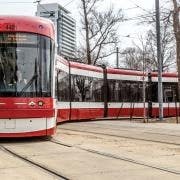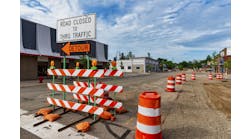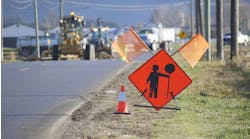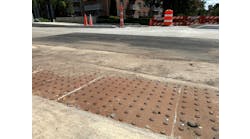Infrastructure changes often come in multiples, if for no reason other than that to alter or install one thing of major significance necessitates the alteration of all things associated with it.
The city of Toronto is undergoing a wide array of transit infrastructure changes under the direction of the Toronto Transit Commission (TTC), some in various stages of planning and/or progress, some mired in political limbo, others waylaid by funding challenges. Nonetheless, much is happening. Among the myriad projects either presently underway or being queued up to begin construction are plans to extend the Scarborough Station Line of the subway rapid transit system a further 7.6 km; augment the city’s light-rail system with more track, more stations and a deeper reach into the surrounding suburbs; retrofit the entire transit commission system for disabled and otherwise physically challenged patrons; modernize all train and bus stations for aesthetic appeal and size expansion; and double-down on the number of platforms, as well as the overall square footage, for the city center’s busy Union Station.
Each of these projects bare out in significant complexity and planning, but they are comparative outliers to two projects of primary import: the extension of the Toronto-York Spadina Subway line and the renewal of the city’s historic streetcar network.
Connecting the region
The Toronto-York Spadina Subway project is an 8.6-km extension of the Yonge-University-Spadina line from its present terminus at Downsview Station (to be renamed Sheppard West Station when the extension is complete) to the Vaughan Metropolitan Centre Station at Highway 7. The expansion will bring the line into the Regional Municipality of York, thus connecting the city with the outlying suburban region—and most importantly, with York University.
“The primary objective was to get the line to York University, which is a major university in the Toronto area,” Andy Byford, TTC CEO, told TM&E. “The university was very keen to get on the subway line, as it is looking to expand as well. One of the further goals was to really expand the region around the city of Vaughan in York Region, northwest of Toronto, and the subway is seen as an economic generator.”
Infrastructure blooming around a new piece of mass transit means more than just a boon to select institutions. Subways are economic generators, not just from fares, but the economic infrastructure that builds up around them. This fact is couched firmly in the TTC’s enthusiasm for York Region development.
“This line extension will have six new stations built into it,” said Byford. “Around the stations we have selected to create, we expect to see significant economic growth, such as businesses, housing developments and building tracts, and the Vaughan region expects to see quite a lot of growth around the Vaughan Metropolitan Centre. There’s not a whole lot out there at the moment. It’s fairly low density, but the completion of the line extension will change that.”
The expansion of the subway and metro centre is estimated to bring 25,000 new residents to the area and install more than 10,000 new jobs, a sizable portion of which will likely be office-related, when work is completed in 2016. “It is the intention of York Regional to make that centre into a hub that has a subway feeding the city and vice versa,” said Byford.
The Toronto-York Spadina Subway extension project will connect York University with the city, opening up a crucial vein of transit that aims to develop York Region overall.
Bring da noise reduction
The Toronto-York Spadina Subway project also is attempting to forward the technologic and materials application that goes into constructing a subway line.
The subway tracks will be bolted to reinforced concrete pads, which then rest on a concrete trackbed in the tunnel. Since concrete on concrete would create noise and vibration, special vibration isolation pucks—basically rubber cushions resembling giant hockey pucks—will be embedded in the underside of the concrete ties, separating the ties from the trackbed. “It is specially constructed to minimize noise and to be exceptionally durable,” said Byford, adding that a modified version of this system also is in place on the city subway’s Sheppard Line.
In total, 35 km of rail and 17.2 km of contact rail will be installed, along with 11,000 reinforced concrete ties, each 1.4 m wide, and more than 56,000 noise-isolation pucks.
Challenges bested
For Byford, 2016’s target date cannot come fast enough, if only to finally see the fruit of all the challenges that have been encountered and addressed since the project first broke ground.
“The main challenge was getting the environmental assessments done in order to know the alignment, the footprints of the stations, the impact on the residents and businesses, notably due to road diversions and tunneling,” said Byford. “The biggest practical planning challenge we had was tunneling under the Seymour Schulich Building on the York University campus, because the tunnel-boring machines had to tunnel just underneath the foundation. But our engineers were able to solve this issue, remarkably, without even a broken window.”
Streetcars have been a staple of mass transit in Toronto for more than 120 years.
Despite overcoming difficulties in the planning stages, actual construction also has brought its share of troubles.
“In terms of construction, that has been challenging,” Byford went on. “There was a work stoppage due to a contractor fatality (unrelated to the work site). Some designs were not completed by the time we began construction, due to the compressed construction time scale, so the teams have had to work around that, as well as utilities challenges that have popped up as we have progressed forward. None of this was exceptional for a large-scale project such as ours. And thankfully now the tunnels are complete, most of the stations are fairly well advanced and the next step will be fit-out.”
When all is said and done, the line extension is expected to further bolster a city perpetually on the cusp of reinventing itself. “It will add to the visual flavor of our city,” Byford remarked. And it will also serve as a fine counterpart to the renewal of Toronto’s streetcar network.
Workers welding rail in the new tunnels.
Keeping the network intact
A brief look at the history of the Toronto streetcar system offers a glimpse of a city rising to meet the needs of its commensurately growing populous. The first streetcars—of the horse-drawn variety—predate the TTC by nearly 60 years, and since the commission’s founding in 1921 the streetcar network has evolved many times, yet has always been in operation. From the first electrified car system in 1892 to the most recent fleet, which have been in service more than 30 years and are now due for retirement, streetcars are seen as a crucial part of the Toronto cityscape.
“Streetcars have traditionally been a part of the transit mix in Toronto,” said Byford, “and they are a very important part of our transit fabric, carrying 250,000 passengers each day. We decided, instead of replacing them with trolley cars or adding a subway, to completely renew the whole streetcar network—and I use that word deliberately—network.”
The streetcar system consists of 11 running lines, which will see new car and reinforced track rollouts steadily through 2019 to the overall tune of $2 billion. “We are buying 204 new vehicles made after the European Bombardier Flexity design,” said Byford, “which are fully accessible with low floors with ramp deployments, and all-door boarding.”
The new 30-m-long cars, which will double the size and capacity of the existing fleet, will run on the existing lines, which will be refurbished with continuously welded, rubber-encased rail to reduce noise and vibration. But powering them was quickly recognized as a challenge. “Now that these new cars are air-conditioned, have power doors, and so forth, we needed new wire to power the cars’ demands. They draw much more power. Moreover, infrastructure changes must be made along the way, whether it is a right-of-way or making curb cuts or making sure curbsides are the right height for the ramps to deploy.”
All about the people
The new cars also will offer a fresh array of conveniences to the traveling public, beyond a smoother ride and fewer bunch-ups along the lines. “We will be progressively upgrading to the Presto Smartcard system,” Byford said. “It is a province-wide program that will replace the existing regime of tokens, transfers and tickets. It is an open payment system that will eventually allow people to pay by debit, credit or over their phone, and eventually to go cashless. It is one of the biggest transformative projects on our docket. Each train will be a point of payment. If it is anything like Oyster (integrated ticketing system) in London, people will flock to it, and we will soon dispense with the traditional legacy payment systems. You can hop on and not worry whether you’ve got a ticket.”
All in all, the reinvention of the streetcar network is expected to function both as a practical public service and, hopefully, put paid to many of the TTC’s fund-sourcing struggles by being an example of exactly how the commission is able to make funding work for the community.
Completed track between Sheppard West and Downsview Park Stations.
“The TTC has the lowest operating subsidy of any North American transit, and it is unsustainable to keep expecting the city to be the only funder of infrastructure,” Byford said. “We have a $2.7 billion backlog of critical projects—not ‘nice to haves’ but critical, must-be-done things. So I am open to where funding comes from so long as it’s sustainable and dependable. There’s no point in having new services or fancy payment systems if the overall system has ground to a halt due to lack of state of good repair. We are presently trying to persuade the province of Ontario to give us some more funding toward [these efforts]. We are looking to expand our secondary revenue sources such as advertising, sale of redundant assets and also potential air rights above certain locations, because you eventually reach a point where fare increases are simply counterproductive. People then find alternate forms of transit and that usually means cars. That’s not what we want.”
Some 56,000 vibration isolation pucks were installed in the Toronto-York Spadina Subway extension.
Based on increasing ridership and overall public support for transit development both within the city of Toronto and its outlying areas, that’s not what the people want either. TM&E



